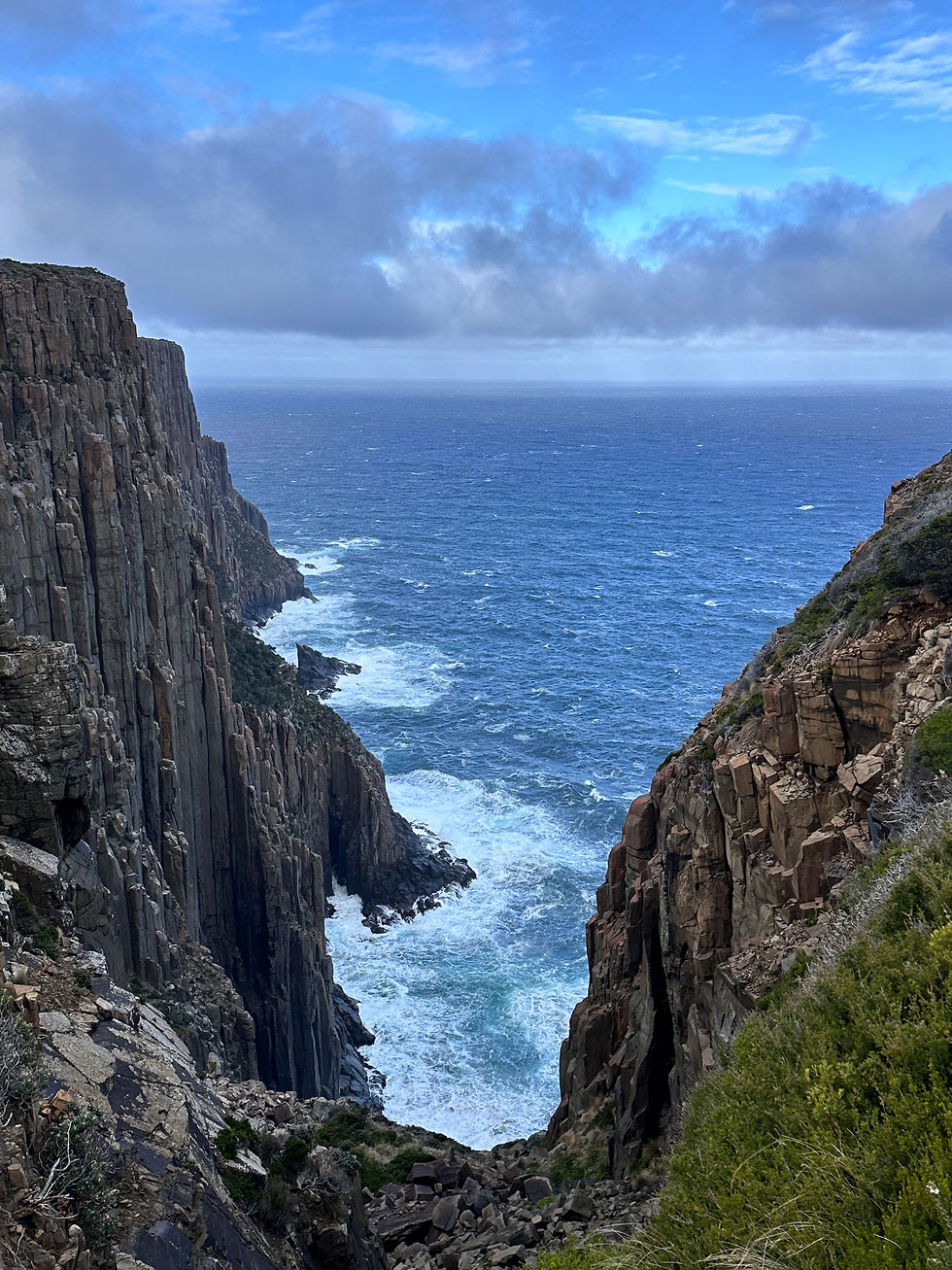6-Day Tasmania Itinerary: A Winter Adventure in Tasmania
- Anna Makarova
- Jul 10, 2025
- 8 min read

In June, my husband received an invitation to attend a conference in Melbourne in mid-July. We’ve always loved travelling to Australia since it’s the closest destination from Singapore when you’re missing and yearning for Western food and culture (5 to 8 hours by flight compared to 13+ hours to Europe). So, there was no question – I would join him in Melbourne and he will take a week off after the conference, so we could explore and experience more of Australia. We decided to go to a place we hadn’t yet explored: the mysterious and alluring Tasmania.
With only 6 days at our disposal, we opted to focus on the East Coast of Tasmania, where the most iconic sights are located. We began our journey in Launceston, a small but charming town in the north, and end our journey in Hobart.
July in Tasmania is winter – the coldest month of the year. If you’re fortunate (or terribly unlucky, depending on your point of view), you might even witness snow-capped mountains and frosty fields. Winter here is not just cold, it’s wet, windy, and raw, so pack your thermal clothes, hiking boots, and a warm rain jacket.
But here’s the upside: July is off-season for tourism. Fewer crowds mean more space for contemplation and nature walks in Tasmania. If you’re not fond of busy tourist hotspots, this is the perfect time to go. Another thing to bear in mind: winter days are short. So, start and finish your day early. After dusk, curious wombats and pademelons wander onto the roads, so keep your eyes peeled—no one wants an unfortunate animal encounter in the dark.
Winter Travel Tips for Tasmania
1. Pack for the Weather. Tasmania's winter can be unpredictable, so be prepared for cold, wet, and windy conditions. Bring a waterproof jacket, warm layers, and sturdy hiking boots. A good pair of thermal socks will make your walks in the wild much more comfortable!
2. Check Road Conditions. Winter in Tasmania can bring unexpected weather, including snow in higher altitudes. Before setting out, check road conditions for any closures or disruptions.
3. Start and End Your Days Early. Days are shorter in winter, sun sets around 5 p.m., so plan to start your adventures early and wrap up by late afternoon. Many parks and hiking areas may close early or become harder to navigate as darkness falls.
4. Watch Out for Wildlife. Australian wildlife is mostly nocturnal. Be especially cautious around dusk, when wombats, pademelons, and other creatures wander onto the roads. Stay alert when driving through national parks and rural areas, and avoid driving at night when possible.
5. Book Accommodation in Advance. Winter is off-season, but that doesn't mean everything is open or available. Make sure to book your accommodation in advance, especially in smaller towns like St. Helens, where options may be limited.
6. Embrace the Silence of the Off-Season. One of the best parts of visiting Tasmania in winter is the tranquillity. With fewer tourists around, you’ll have popular destinations like Cradle Mountain, Bay of Fires, and Freycinet National Park all to yourself. Enjoy the quiet moments in nature and let Tasmania’s untouched beauty work its magic.

Day 1: Launceston to Cradle Mountain
We took an early flight from Melbourne to Launceston, landing in a tiny airport. After grabbing our rental car, we headed straight for Cradle Mountain National Park. The drive from the airport is about two hours, but with the off-season crowd absence, we had no trouble with parking or queues.
To enter the park, you’ll need a National Parks Pass. We opted for the two-month pass, as the daily and annual options didn’t quite suit our short stay. You will need this pass not only in Cradle Mountains, but also in Freycinet National Park, Tasman National park, and many more.
Once inside Cradle Mountain National Park, it’s worth noting that you can’t drive into the park itself. Instead, there’s a shuttle that makes four stops, Dove Lake being the most iconic.
Now, before you head out, do yourself a favour: stop by the Visitor Centre café and pick up a couple of apples for your walk. I don’t know if we were just starving or if those apples were truly magical, but they were easily the best apples I’ve ever eaten!

Most of the shuttle riders were headed for Dove Lake, and there’s a loop track around it that’s relatively flat and easy to walk. The good news is, most tourists turn back after the Boat Shed, leaving the rest of the trek peaceful and uncrowded. The views of the lake, the mossy forests, and the mountains are enchanting, and we even encountered some wildlife along the way.
We finished the loop in good time, feeling refreshed (thank you, Tasmanian apples!), and since the sun was up, we decided to take a small detour from the Boat Shed to Wombat Pool. It’s a short but steep walk with lots of stairs, and at the top, you’ll be greeted by a small, serene lake. Sadly, the gloomy weather kept us from seeing the mesmerizing reflections that a sunny day would offer, but the walk itself was still worth it.

We then followed the Lake Lilla Track, which merges with the famous Overland Track. Along the way, keep your eyes open for wild wombats. Winter is the best time to see them, and we were lucky enough to spot three!
The day ended at our nearby hotel, though one thing I regret not doing was visiting the Devil’s Sanctuary. The Tasmanian Devil, unfortunately, is a rare sight these days due to the Devil facial tumour disease, but the sanctuary plays an important role in preserving these remarkable creatures. If I had the chance to return, it would be top of my list.
Day 2: Cradle Mountain to Launceston
Today was reserved for short, easy walks. We started with the Enchanted Walk, a gentle trail that was, indeed, enchanting, especially with the countless pademelons (the smallest of the kangaroo family). We then made our way to the King Billy Tree walk, a peaceful forest trail, before concluding with Knyvet Falls, a 20-minute walk that leaves you standing on top of the waterfall rather than in front of it, which was a bit of a letdown.
After a lovely morning, we bid farewell to Cradle Mountain and began our drive back to Launceston. We had planned to stop at Marakoopa Cave, famed for its glowworms and stunning geological formations. However, the cave was closed due to a recent storm that had blocked the entrance with a fallen tree. Disappointed but not defeated, we made our way to Christmas Hills Raspberry Farm for a much-needed lunch break. Their raspberry desserts were a sweet balm for our travels, and we even bought jars of homemade raspberry jam to bring home – a sweet reminder of our trip.
Launceston is small but charming. It has a quaint feel, with well-preserved old houses and shops. But, in truth, Launceston doesn’t warrant a long stay; we only stopped for the night before continuing our journey east.
Day 3: The Bay of Fires

The drive from Launceston to the Bay of Fires was meant to be a short one. But, in typical travel fashion, my husband’s undying loyalty to Apple Maps led us down a dusty rural road, where I found myself moving fallen trees out of our path. What should have been a 2.5-hour drive turned into a much longer ordeal. Yet, after all that, the view at St. Columba Falls made it worth it. The waterfall is hidden deep in the forest, but you can hear it roaring from the carpark. The short walk to the falls is easy, and the view is breathtaking.
Next, we made our way to The Gardens at Bay of Fires. The red boulders there are iconic, but after all the hype, we were a little underwhelmed. Perhaps we were simply too tired from the long drive. Still, the views were lovely.
We made several more stops along the way:
· Binalong Bay National Whale Trail
· Skeleton Point
· Grants Point
Grants Point, in particular, was a highlight, with short, easy walks and magnificent coastal views.
Day 4: Freycinet National Park
After grabbing our usual dose of Aussie coffee, we headed for Freycinet National Park, eager to hike around Wineglass Bay and Hazards Beach. The 12km hike requires a bit of fitness, with a steep ascent at the start, with the promising views. The lookout offered a nice, view of Wineglass Bay. After taking a couple if pictures on the top, we made our way down to Wineglass Bay Beach and then looped back to the car, meeting several pademelons and some curious birds along the way.
Post-hike, we made a detour to Cape Tourville Lighthouse. The windswept views from here were nothing short of stunning, and, if you're lucky, you might even spot a whale. We weren’t so lucky, but the experience was still unforgettable.

Day 5: Cape Raoul
It’s a three-hour drive from Freycinet to Cape Raoul, so start early! The 16km Cape Raoul hike is challenging, with plenty of ups and downs. Overall walk felt like a good cardio workout and was very worth it! The views from the lookouts at the end were nothing short of magnificent. We even spotted some black cockatoos along the way, though wildlife sightings were scarce.
The wind at The Gap lookout was ferocious, so hang onto your hats! But the view of the cliffs and geological formations was worth every gust. Don’t miss the two lookouts at the end: Cape Raoul Viewing Point and Seal Rock Lookout. You’ll be rewarded with breathtaking views, and if you're lucky, seals basking on the rocks.


Day 6: Port Arthur
We began the day with a Tasman Island Wilderness Cruise, an exhilarating, bumpy ride on a small speedboat. The crew gave us stomach settlers, waterproof coats, and hand warmers, but the wind and cold were unrelenting. The cruise itself was thrilling, offering incredible views of rock formations, caves, and the ever-watchful seals.
Afterward, we visited Port Arthur Historic Site, an impeccably preserved former convict settlement and a UNESCO World Heritage Site. The guided tour was both informative and fascinating, offering insight into the island’s grim history. The tour also includes a short boat ride, but it is a very skippable experience, unless you want that iconic photo of the prison from the water, it’s not necessary.

We wrapped up the day by rushing to Hobart, where we arrived too late to explore. The historic centre of Hobart looked charming, with many restaurants and bars to choose from.
Epilogue
Six days in Tasmania felt like a mere glimpse of this captivating island. We missed so many sights like Mount Wellington, MONA (Museum of Old and Modern Art), Bruny Island’s white kangaroos, and Bicheno’s penguins. We also didn’t have time to explore Tasmania’s wineries or visit all the beautiful remote locations.
But one thing is certain: we will return. Tasmania is a destination that lingers in the soul – peaceful, friendly, and impossibly beautiful.

























Comments